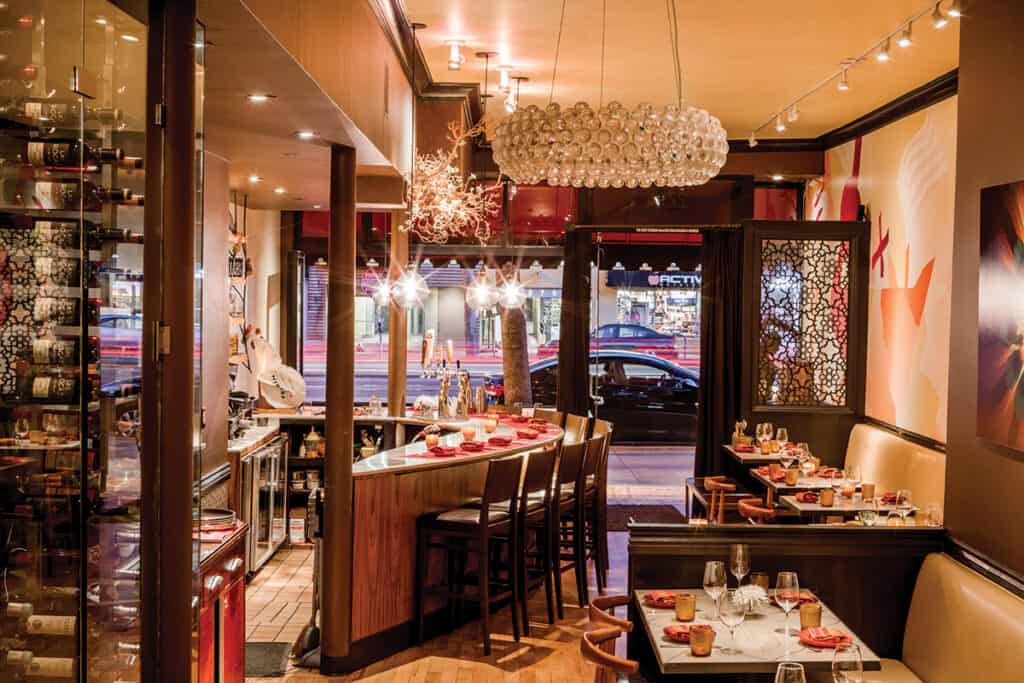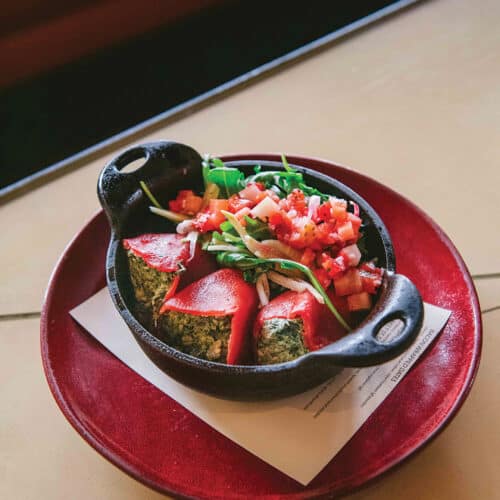Mat Schuster Brings the Warm Flavors of Spain to San Francisco
PHOTOGRAPHED BY HARDY WILSON
While San Francisco is indisputably a diverse food city with Indian, Middle Eastern, and Asian cuisine in almost every neighborhood, Spanish food can be harder to find. That was especially true until 2011, when chef Mat Schuster and his life and business partner Paco Cifuentes opened Canela Bistro and Wine Bar on Market Street, bringing patatas fritas and paella to the Castro neighborhood. More than 10 years later, the cozy and welcoming bistro is still serving loyal customers both traditional Spanish and Spanish-inspired California cuisine, along with an ever-changing, exclusively Spanish wine list.
In many ways, Schuster’s path to opening and cooking at his own restaurant was not typical. The Texas native studied business administration at Emory University in Atlanta, Georgia, but a college roommate who noted he was “always cooking” suggested he go to culinary school. Schuster set off for California, and in 1999 earned a degree from the California Culinary Academy (CCA) of Food, which was a satellite program of the CCA in San Diego.
Schuster’s interest in Spanish cuisine came into focus when he met Cifuentes while teaching cooking classes at Whole Foods Market in San Mateo. Thus began many trips to Spain—mostly to La Rioja, where Schuster “staged” (the professional kitchen term for an internship) in several Michelin-starred restaurants, including Echaurren and Venta Moncalvillo.
At Canela, Schuster’s cooking draws on these experiences, as well as more traditional, regional Spanish food. “There’s a lot of cooking for mama, but also molecular gastronomy—lots of really cool stuff,” he says. The diverse menu includes multiple tapas options, which can be ordered à la carte, or from two special menus: the chef ’s tapas tasting menu, and the paella and tapas prix fixe menu.
On the à la carte tapas menu are nine quesos de Espana that diners select from to build a board (or pretty pink ceramic platter) that comes with a bite of spicy charcuterie, olives, and honeycomb. Arzúa-Ulloa, a cow’s milk cheese from the Galicia region has a tangy, yogurt-like flavor and is a favorite of Schuster’s for its creamy texture and versatility. Other offerings include Manchego and Pica Oveja—a sheep’s milk cheese from La Mancha that’s aged for 120 days and infused with spicy chili, which gives it a considerable kick and a sunset-orange hue. The Smokin’ Goat, one of three goat cheese offerings, is a semi-soft pale white cheese with pleasant smoky notes that complement the milky flavors. Ajo Negro is an umami-packed delight made from sheep’s milk with plenty of punch from black garlic.
Alongside classic Spanish fare such as patatas bravas and jamón Ibérico, Schuster puts his own twist on tradition with a pear almond gazpacho and his Market Street salad, which includes pomegranate seeds, pickled carrots, kumquats, and a persimmon vinaigrette. And a sweet and spicy sofrito adds depth and intense savory flavor to the pickled cherry tomato and serrano chile coca flatbread that’s topped with fresh arugula and feta. One of the most popular items on the menu is the gambas al ajillo or shrimp with fermented black garlic and preserved lemon, which bring just the right balance of savory and tart to the seared shellfish.

Both the food and the restaurant’s environment are Spanish inspired. “Our design for Canela is meant to conjure the feeling of being in the south of Spain, particularly Andalusia, where Paco’s mother grew up,” explains Schuster. The restaurant’s many personal touches include tables with inlayed Arabic laser woodcut designs, which were custom made by a friend. The whimsical orange and red logo was also created by an artist friend, and warm colors, punctuated with soft brown tones, are carried throughout the dimly lit space.
Schuster spent much of his early career teaching cooking classes at some of the best culinary retailers in the Bay Area, including Draeger’s Market and Ramekins Culinary School, so it’s not surprising that he continues to educate and introduce new audiences to Spanish cuisine. Along with his executive chef duties at Canela, he also works with the Trade Commission of Spain, providing cooking demonstrations at tradeshows using Spanish products. He and Cifuentes continue to visit Spain, always with an eye to broaden their knowledge of Spanish food and wine—and so Schuster can apply what he learns in his own restaurant kitchen, where he embraces his role as a culinary ambassador for his adopted country.

Stuffed Piquillo Peppers with Greens, Spanish Goat Cheese, and Strawberry Salsa
Ingredients
STRAWBERRY SALSA:
- 1/4 cup diced red onion
- 1 cup diced red bell pepper
- 1 cup diced strawberries
- 1 tablespoon minced parsley
- 1 tablespoon extra-virgin olive oil
- Dash champagne vinegar
- Kosher salt and freshly ground black pepper, to taste
STUFFED PEPPERS:
- 2 tablespoons olive oil, plus more for serving
- 2 large shallots, peeled and sliced
- 1 teaspoon minced garlic
- 2 cups greens (collard, mustard, kale, chard, or your favorite greens), washed and chopped
- 2 cups soft Spanish goat cheese (try MitiCana de Cabra), plus ¼ cup to garnish
- 1 lemon, juiced
- Kosher salt and freshly ground black pepper, to taste
- 24 jarred or canned piquillo peppers, drained
Instructions
STRAWBERRY SALSA:
- Combine first six ingredients in a small bowl and season with salt and pepper.
- Refrigerate until needed.
STUFFED PEPPERS:
- Heat a large sauté pan over medium heat and add olive oil. Add shallots and cook until translucent, then add garlic and cook for 1 minute.
- Add greens and cook until wilted. Set aside to cool.
- Heat oven to 400°F.
- Crumble goat cheese into cooled greens and mix well. Add lemon juice and season with salt and pepper.
- Stuff mixture into pepper cavities until they are plump.
- Place stuffed peppers in an oven-safe dish and bake for 10 minutes.
- Remove from oven and garnish with cheese.
- Serve with strawberry salsa and a drizzle of olive oil.





